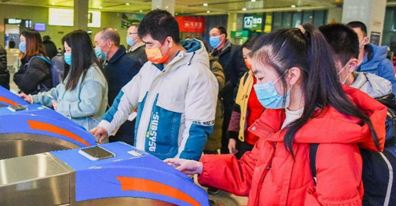By Cui Yan, People’s Daily
Inside a museum at Shijiazhuang Railway Station of the China Railway Beijing Bureau Group Co., Ltd., train tickets collected over the years are on display. The tickets, including hardboard tickets, soft paper tickets and magnetic tickets, are witnesses of the changes taking place in China’s rail transport sector.
In recent years, train tickets are going paperless in China, and e-tickets have been rolled out for high-speed trains and intercity trains. From paper tickets to paperless tickets, China has constantly upgraded railway services and made travel more convenient.
The first generation train ticket in China was the hardboard train ticket which required the ticket seller to print all information manually. It would take several minutes for the ticket seller to create one such ticket.
In the 1990s,asoftred paper ticket printed with a computer system was rolled out. After typing the date and serial number of the train manually, the ticket seller could create one such ticket, cutting the ticket issuing time to seconds.
In 2008, the blue magnetic train ticket was introduced as the Beijing-Tianjin high-speed intercity railway went into operation. The ticket can go through the automatic ticket checks. Nowadays, as digital technologies, such as facial recognition, have been applied, electronic train tickets are provided.
What drives these changes are technological progress and people’s aspiration for a better life.
In the past, people might have to queue up for a whole night before purchasing a ticket bound home; nowadays, they can buy a ticket at one click. Passengers using e-tickets can even pass checks by scanning their ID. This reduces the time passengers spend checking in by more than one-third and eliminates risks of losing tickets, reporting the loss of tickets and repurchasing of tickets.
In 2022, the Kunming-Mohan section of the China-Laos Railway unveiled two new tickets: a multi-ride ticket and a periodic ticket. Ticket holders can travel several times along the route at a discounted price. This move has offered convenience for business travelers and commuters, showing that buying and using train tickets has become much simpler and travel has become more convenient.
The continuous upgrading of train tickets and improvement of passenger experience are attributable to the burgeoning development of the railway sector. Over the past nearly 10 years, the size and quality of China’s railway network have grown significantly, the quality of the country’s rail transport service has moved to a new level and rail equipment and technology have become more advanced.
By the end of 2021, the operating length of China’s railways surpassed 150,000 km and the length of high-speed railways in China accounted for more than two-thirds of the total length of such networks worldwide.
In the peak traveling season, passenger trains make more than 10,000 trips on average per day. Easier movement of people and smoother flow of goods has been basically ensured. Thedeveloped transport networkwith internal and external traffic connections has not only firmly supported the high-quality economic and social development of the country, but also continuously raised the quality of people’s life.
The 2023 Spring Festival travel rush has kicked off in China and there has been a growing demand from passengers for visiting their family members and travel. Many localities and departments in the country have taken measures to ensure a smoother and more heartwarming homebound trip for passengers.
For instance, a code scanning service has been introduced on more than 3,200 bullet trains running in the country. By scanning the code on the train seats, passengers can easily get the travel information and services about their trips.
As China furtherboosts transport infrastructure and improves the capacity, quality and efficiency of transport service, people’s demand for high-quality travel will be better satisfied.
Passengers pass checks by scanning their ID at Qijiang East Railway Station in southwest China’s Chongqing municipality, Jan. 7, 2023. (Photo byChen Xingyu/People’s Daily Online)

















